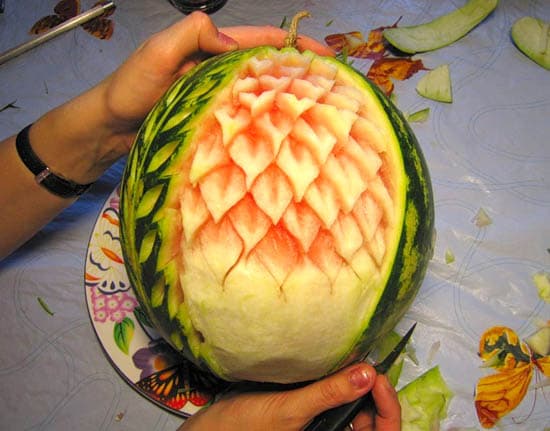Mid-season variety, ripens 80-85 days after seedlings are planted in the ground. It is distinguished by its unpretentiousness and drought resistance, very sweet taste and high transportability.
Recommended for growing in open ground and under film covers. The plant is powerful, with excellent growth vigour and medium-length vines. Forms ovaries well in any conditions. The fruits are spherical, medium-sized, whitish, with narrow dark green stripes, weighing 4-7 kg. The pulp is bright pink, juicy, sugary and crispy. The taste is sweet, with a pronounced watermelon aroma.
The peel is not thick, but dense, which makes it easy to transport and store the fruits of this variety.

* Watermelon is an annual herbaceous plant of the Cucurbitaceae family. The watermelon's root system begins to develop before the cotyledons emerge from the soil and reaches its maximum size by the time the plant blooms.
Watermelon has a taproot that penetrates the soil to a depth of 1 m and is highly branched. From the main root, 15 (sometimes more) lateral roots branch out, which also branch into finer rootlets. Thus, a powerful root system develops in the arable soil layer at a depth of 15-30 cm, covering up to 7-10 m³ of soil.
A unique feature of the watermelon root system is its strong suction power, which can utilize moisture from soil at 6% humidity and even from the dry sand of the Karakum Desert.
The suction force of watermelon sprouts reaches 1 MPa (10 atmospheres). This explains the plants' drought resistance and ability to thrive in poor, sandy soils.
Watermelon vines are creeping, long, in some years reaching five or more meters, very branched, forming lateral shoots of the second order, which, in turn, also branch out.
The shoots (especially young ones) are covered with long, woolly hairs that protect the plant from overheating.
Vegetative growth initially develops very slowly, while the root system grows rapidly. However, 20-30 days after emergence, provided the weather is favorable, the plants grow rapidly, form shoots, and bloom. During this period, the growth of all shoots on a single plant can reach up to 2 cm per day.
Watermelon is a monoecious plant with dioecious flowers. Depending on the variety, watermelon seeds come in a variety of shapes, sizes, and colors.
Preparing the soil.
Sandy soil with humus or sandy soil is very good for growing watermelons.
Watermelons grown in heavy soils tend to become misshapen and lose sugar content.
Watermelons should not be grown in the same place year after year to avoid diseases.
Planting beds must be prepared in such a way that they provide a stable position for the fruits.
Fertilizer.
Fertilizer application should be based on soil testing, although watermelons are quite tolerant of a wide range of soil acidity: pH from 5.0 to 8.0.
Agronomist research shows that watermelons utilize a lot of nitrogen, potassium, calcium, and phosphorus: the basic fertilizer rate is 330 kg of 10-10-20 fertilizer per hectare, which is the most suitable amount for most soils. It is recommended to apply 35 to 45 kg of nitrogen per hectare, 30 cm on each side of the plant, to prevent the growth of side shoots.
Sowing and transplanting.
The direct-seeding method is a well-known method for growing watermelons. Three to four seeds are sown in a mound at a depth of 3-4 cm. The seeds are sown after all danger of frost has passed.
Transplanting young plants is another well-known method for growing watermelons. Seeds are planted in peat or other pots in a greenhouse or warm beds to germinate.
Repotting is done when there is no longer any danger of frost. Repotting is done before the first true leaf appears.
Mulching.
If you cover the soil with plastic mulch, it warms up faster: warm soil is most favorable for watermelons.
Lay the plastic sheeting over the beds and cover the edges with soil. Cover all sides to prevent the wind from blowing it away or fraying it. Poke holes in the plastic sheeting for sowing seeds or planting seedlings (black material is preferable as it will prevent weeds from growing underneath).
The soil retains moisture and nutrients, preventing leaching.
Removing braids.
Pruning is not necessary when growing watermelons. If there is sufficient moisture and good pollination, watermelons will thrive on their own.
Pollination.
Male and female flowers are separated on the same plant. Bees and other insects pollinate the flowers, ensuring the proper development of the fruit.
But for commercial fields, beehives should be placed nearby: under normal conditions, one hive provides pollination for 1 hectare of watermelons.
Watering.
Watering should be maintained throughout the early growing season to ensure healthy plants and abundant flowering. Once the fruit has reached the desired size, watering should be reduced or avoided during the ripening season. Sugar content is typically higher and the flavor more intense if watering levels are not too high during ripening.
Pest control.
Striped and spotted cucumber beetles and melon aphids are the most dangerous pests of watermelons. It is recommended to follow the instructions for using insecticides to control cucumber beetles.
Fight against diseases.
Anthracnose, downy mildew and fusarium are the main diseases affecting watermelons.
Anthracnose and downy mildew are controlled by spraying with fungicides.
Fusarium cannot be controlled with chemical fungicides, and therefore it is necessary to select resistant varieties or use biological control agents (for example, Fitosporin).













